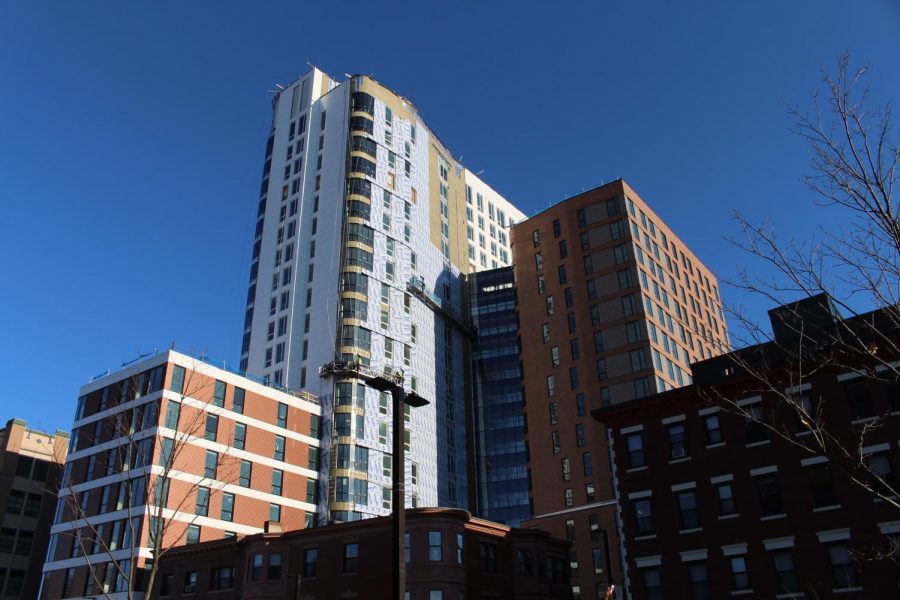Op-ed: Overcoming gentrification as much as we can
The construction of Lightview has sparked much controversy surrounding gentrification in the Roxbury community.
February 2, 2021
Last summer, when Northeastern announced it was implementing the NUflex program in the fall and inviting students back to campus, the city of Boston was skeptical. Contagious disease experts, including an NU epidemiologist, recommended that Massachusetts return to at least Phase 2 of the state’s reopening plan to curb cases. There was no major surge in cases at that time, but there were indicators that there was one coming.
Despite these reservations, NU made the decision to press forward with its plans for in-person classes. Although it appears the university’s gamble paid off — there was no surge of cases on campus even after students returned for the fall semester — I believe that Northeastern should offer some recompense for the potential increases in coronavirus exposure to the local community. One way the university can do that is by reversing some of the negative effects of gentrification caused by the expansion of college campuses.
Boston is one of the most gentrified cities in the country; it is third only to San Francisco and Denver. While gentrification leads to improved housing and infrastructure, as well as commercial advances, there are many negative impacts that undercut the value added to the community. This includes the forced displacement and exclusion of low-income families, especially among people of color. And once gentrification begins, there is no going back.
Last year, the mayor of Boston announced an initiative to counterbalance these effects. He pledged to devote $500 million to build more affordable housing, but his pledge only served to increase the disparity between the lower-income and the more affluent, rather than redress it. The money poured into refurbishing these neighborhoods attracted more affluent people who took up residence in these communities. Take the Boston Seaport as an example. The rebuilt neighborhood is now 89% white residents. The 3% Black residents have not benefited from the renewal.
The history of encouraging minority economic growth is not new, as seen in the 1980s Parcel to Parcel Linkage Program. The city pledged that if a developer purchased a parcel of land in downtown Boston, then they would commit to build on a parcel of land in Roxbury. Northeastern’s new Lightview building plans are set to take place on one of these parcels of land that the University bought from foreclosure in 1997, and will not benefit the Roxbury community as the program originally intended. This is yet another example of being all talk and no action. The University focuses so much on the pillar of community – yet continues to keep Roxbury and minorities outside of it.
However, it is important to realize that the development of new neighborhoods is not the problem. The core problem is zoning — once a neighborhood redevelops, its wealthy residents use zoning regulations to keep low-income people out. The solution is not to fight development, but rather to fight the misuse of regulation.
To truly reverse the effects of gentrification, there needs to be a widespread liberalization of zoning. For example, activists employ “downzoning” to increase affordable housing in gentrified neighborhoods. A developer who wants to build homes on a lot must obtain a variance. Downzoning regulations require that at least one-third of the units built on the lot need to be affordable housing. However, these initiatives take time to have an effect. In the meantime, the existing low-income community suffers. This is where universities like Northeastern can help. Although they can not truly solve gentrification, the university should find ways to encourage students to invest in the Boston community and leave it better than they found it.
Certain existing Northeastern programs can be expanded to assist the community. Swipe2Care is a campus program for students to donate extra meals to their peers on a voluntary basis. Students should be encouraged to use the program, not only to donate extra meals to students, but to also provide meals to people who need them in the city. If the meals were given to those in need or those who sign up for them, even if recipients do not belong to the Northeastern community, the program would be more widely used.
Students should also be encouraged to donate more to thrift stores. There is a gap in regards to what is consumed versus what is replaced. Furniture and clothes are often thrown away as students move into new places throughout their college years. Northeastern should encourage students to donate more used clothing and extra furniture to local thrift stores.
Northeastern could also kickstart a horticulture club that would invest in rooftop or city gardens. This could work in tandem with Boston public gardens to increase the amount of fresh and local produce available to the public. They could also increase funding to NU Mutual Aid and other food drives while creating more clubs like Peer Health Exchange, which trains college student volunteers to teach a skills-based health curriculum in public high schools. Similar clubs could tutor students in Boston public schools and assist them with preparing college applications.
Gentrification is often talked about, but few are writing about the alternative ways we as college students can combat its detrimental effects. In a city environment, it is especially crucial to look around and remember that there is always more you can do to help your adopted home. Even though places like Seaport are beautiful and modern, we cannot ignore how these aesthetically pleasing redevelopment projects worsen disparities between the affluent and low-income. Northeastern has the potential to serve as a catalyst to make our campus, local community and the entire city more balanced and socially conscious.
Maeve Singer is a first-year computer science and environmental science combined major. She can be reached at [email protected].


















